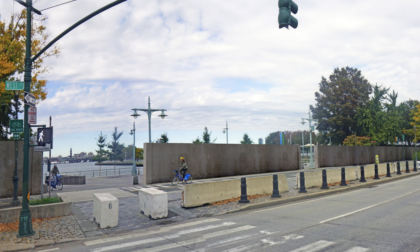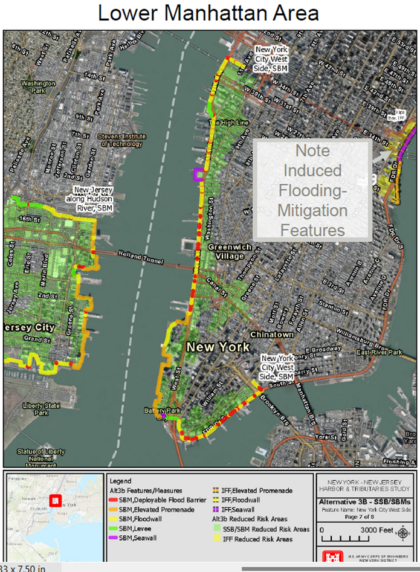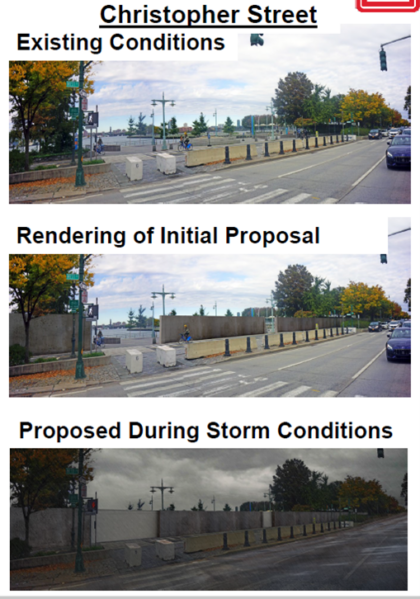Army Corps has plans to build a wall down the westside
I haven’t dug into this one yet but I thought everyone should see this image (it’s of Christopher Street, but we can extrapolate) now so they can whine along with me. The federal Army Corps of Engineers has released rather shocking plans for the city to deal with future floods, and their proposal for our area so far — it’s preliminary — calls for a concrete wall to snake down the Westside Highway.
(This is not to be confused with the city’s Lower Manhattan Coastal Resiliency Project — the Mayor’s Office of Climate & Environmental Justice wrote to ask that I note that the Army Corps study is a separate process.)
I’m hoping this is one of those things that never gets built; they have been working on the plans since 2016. But it’s outrageous. It also seems to me that it is not all that inventive. The wall would be permanent, and during flood warnings, a temporary wall would fill in the gaps at the crosswalks.
The study shows much of Tribeca being underwater without any mitigation for floods.
In addition to the floodwall (the yellow line) there are deployable barriers (red), elevated promenades (orange, in Battery Park City) and levees (green). There’s also a seawall, show in purple. The study is scheduled to conclude in 2024.
You can find more info here, or peruse the presentation yourself here.
You can also email, call or send written comment. The deadline is March 7.
Mr. Bryce Wisemiller, project manager
US Army Corps of Engineers New York District
Jacob Javits Federal Building, Room 17-401
c/o PSC Mail Center
26 Federal Plaza
New York, NY 10278
917-790-8307
nynjharbor.tribestudy@usace.army.mil
















It seems like the prior proposal – the New York Harbor Storm-Surge Barrier, which consisted of one barrier located across the mouth of Lower New York Bay between Sandy Hook and Rockaway and a second on the upper East River was shelved.
This is part of the new proposal which is a series of sea gates — movable walls to be closed only for major storms — that would block waterways around Brooklyn, Queens, Staten Island and New Jersey, along with 31 miles of land-based levees, elevated shorelines and sea walls.
I would much prefer one sea barrier to many and see walls.
Absolutely prefer the one sea wall solution … which you can close and raise up when necessary… The additional benefit of course is that it would protect the coast lines of both NY & NJ
Horrendous… seriously what else are they going to throw at us… i mean why cant we do something like London? instead we do this ghetto solution…
And by London I mean sea barriers… which actually is used in many cities around the world.
Because we have Ghetto designers working for the city… Obviously a sea wall is the correct and proper solution. Perhaps their usual construction company “friends” can’t er… “participate” in that type of solution? I would love to hear the explanation. This is going to be ugly beyond belief
This is the Army Corps, not the city.
Agree it’s ugly, but it’s not likely to ever happen.
Was part of the mandate to come up with the ugliest looking solution possible? Did someone say “let’s bring the charm of the New Jersey Turnpike to Manhattan’s West Side?”
This is a horrifying proposal, with implications for public safety, access and nature. We all need to submit public comments to stop this (drafting mine now) and push for a solution that preserves the treasured public space that is Hudson River Park.
The U.S. Army Corps of Engineers has a very poor historical record when it comes to heavy-handed attempts to control nature, and in particular water. See, for example, the redirected/leveed Mississippi delta, the concrete-laden Los Angeles River, the increasingly saline Florida Everglades and inter-coastal, the reversed/flooding Chicago River, etc.
Rather than embark on an extremely expensive and ugly project that disconnects the city from the heavily-used and very popular waterfront, the city should first consider alternative (cheaper) solutions that attempt to use nature as an ally: oyster beds, restored marshlands, rain basins, permeable paving, etc.
The following is a wonderful short article on the merits of such an approach, which has the added benefit of improving the natural environment we all indirectly depend upon whilst also protecting humans and property: https://www.newyorker.com/magazine/2021/08/09/the-seas-are-rising-could-oysters-protect-us
This is the cheaper alternative. It’s cost is estimated at $52Billion where as the New York Harbor storm surge was around $110 Billion.
The actual costs will inevitably be much higher.
In any case. We can’t wetland our way out of future flooding and the next Sandy.
Sadly… it just occurred to me that they might realize that given what is going on with global warming and climate change the seas will only continue to rise higher and higher. So we are not looking for a temporary storm specific solution but rather a long term one. Yet I think what should be considered instead is a permanent sea wall – with channel openings and locks through which to allow seabound traffic. The only real solution.
Interesting to note… If you study their plan link brochure you will notice they are creating this same described wall/barrier system in New Jersey – See Blue lines in Perth Amboy and Between Staten Island and Bayonne.
To me a far more intelligent solution would do something very similar for the West coast of Manhattan / East coast of New Jersey bu going right across the footprint of the Verezzano-Narrows bridge.
https://www.nan.usace.army.mil/Portals/37/docs/civilworks/projects/ny/coast/NYNJHAT/Brochures%2022/Brochure.pdf?ver=UEOGOuDYfKX-J86V6RHzrQ%3d%3d
I sent them an updated suggested plan – with sea walls along the Verazanno-Narrows Bridge and along the Throgs Neck Bridge. Will eliminate miles and miles of their ugly walls all alone Eastern NJ, Western Manhattan, Eastern Manhattan, and parts of Long Island too. Here’s hoping some reason prevails…
The water in New York Harbor is rising at the rate of one-tenth of an inch per year–not a full inch as the people promoting climate panic like to claim.
I know. Things are about to “accelerate.” The models, which haven’t been right yet, “prove it.” D’oh!
This wall should come in handy in the year 2500.
I think the primary concern is what happens when the ice caps and glaciers start melting faster … this is happening already as you know … unfortunately… and the fear is this certainly could accelerate and get worse
We have time to see how that plays out. The acceleration argument has been made for years and it hasn’t worked the way it’s been predicted. Even the most recent IPCC whacked its prediction of temperature increases in half.
There’s a lot less consensus around this issue than one might think. Not only do scientists disagree, so do their models, which are often contradictory.
I would love to see a climate model that could accurately assess what’s already happened, which would be more credible in predicting the future. Alas, I don’t think we have a good fix on this. An accumulation of very selective anecdotes doesn’t make a convincing case to me for follies like this hideous wall.
I think you may need to update your data. So far the predictions have been quite accurate and if anything too conservative. The next Sandy could come sooner than you think because the rate is not linear. It is speeding up and going to get worse. A tipping point may be near. That said, I think a London-like Thames river barrier gate makes more sense.
Maybe we should just accept that lower Manhattan will flood from time to time, at least until it is eventually underwater in the 22nd century perhaps.
But until then, let’s skip the Berlin Wall vibe, which likely won’t actually prevent water from infiltrating anyway, but would wall Manhattan off from it’s waterfront.
Then focus on protecting smaller areas, like tunnel entrances and subways. And work on upgrading buildings and utilities where they won’t be damaged by ever increasing salt water inundation.
A common sense approach, I like it.
So soon NYC will be the City at the End of the World in “Artificial Intelligence”?
Great idea Robert. Now that makes more sense, if flexible, and will be potentially within budget.
Not sure if these planners have realized – but there aint any money for these plans, ugly or elegant.
i like th e idea but they shoudl make all these walls clear so you can see through…I am sure there is something besides cinderblocks or cement or whatever they are using that will be more pleaseing to the eye and not block the views is why we like to live down here
If you make the wall out of glass and the water rises we can make it like an aquarium and people can come visit and see the fish and other wildlife.
This is the dumbest idea ever. Looks ugly too.
This is so low-tech. Frankly, I am outraged.
I mean…how and why anyone would think this is a good plan………. escape from NY. 1987 movie….lol
I grew up in Rhode Island home of the 1939 hurricane which flooded the state and city with 12 foot water. After years of the same (Hurricane Carol, etc) we built a hurricane barrier IN THE OCEAN which has prevented flooding ever since. Surely the Army has the intelligence (I’m joking) to do the same at the mouth of a RIVER to stem the growing waters we know are coming. I think we all need to write our elected officials now to kill this wall before a dime is spent even studying it. Studying Rhode Island.
How about lowering the water level by creating a massive tube into outer space which the vacuum would draw water away from the Earth and into outer space?